

Kidney Transplantation Guidelines & Reviews. CKD Guidelines & Reviews. Obesity & Bariatric Surgery Guidelines. Kidney Stones Guidelines. NKF KDOQI Guidelines. Microbiome & the Kidney. Diagnosis and management of osteoporosis in chronic kidney disease stages 4 to 5D: a call for a shift from nihilism to pragmatism. 1.Moe S, Drueke T, Cunningham J, Goodman W, Martin K, Olgaard K, Ott S, Sprague S, Lameire N, Eknoyan G (2006) Definition, evaluation, and classification of renal osteodystrophy: a position statement from Kidney Disease: Improving Global Outcomes (KDIGO). kidney int 69:1945–1953PubMed CAS Google Scholar 2.(2001) Osteoporosis prevention, diagnosis, and therapy.
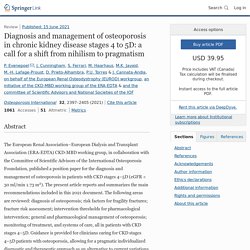
JAMA 285:785–7953.KANIS JA (1994) Assessment of fracture risk and its application to screening for postmenopausal osteoporosis: synopsis of a WHO report. WHO Study Group. Osteoporos Int 4:368–381CAS Google Scholar 4.KANIS JA, Cooper C, Rizzoli R, Reginster JY (2019) European guidance for the diagnosis and management of osteoporosis in postmenopausal women. Osteoporos Int. 30:3–44PubMed CAS Google Scholar 5.Hernlund E, Svedbom A, Ivergard M, Compston J, Cooper C, Stenmark J, McCloskey EV, Jonsson B, JA KANIS (2013) Osteoporosis in the European Union: medical management, epidemiology and economic burden.
Healthful dietary patterns and risk of end-stage kidney disease: the Singapore Chinese Health Study. Reassessing the Inclusion of Race in Diagnosing Kidney Diseases: An Interim Report from the NKF-ASN Task Force - American Journal of Kidney Diseases. The dietary management of potassium in children with CKD stages 2–5 and on dialysis—clinical practice recommendations from the Pediatric Renal Nutrition Taskforce. The composition of the PRNT and the detailed development process for the CPRs, literature search criteria, grading of evidence, and plans for audit and revision of the CPRs have been described [2, 3].

The PICO (Patient, Intervention, Comparator and Outcome) format [4] has been used to develop recommendations that provide specific actionable advice, including choosing between alternative approaches in particular clinical situations. PICO terms. ESPEN guideline on clinical nutrition in hospitalized patients with acute or chronic kidney disease - Clinical Nutrition. Uremic Sarcopenia and Its Possible Nutritional Approach. 1.
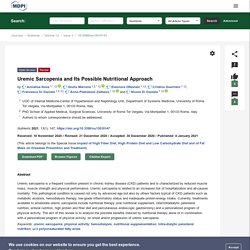
Introduction “Sarcopenia” is a term derived from the Greek “sarx”—meat and “penia”—loss, and it was first coined in 1988 by Irwin Rosenberg to describe the modifications that occur in the muscles during aging [1]. KDOQI Clinical Practice Guideline for Nutrition in CKD: 2020 Update - American Journal of Kidney Diseases. Institute of Medicine (US) Committee on Standards for Developing Trustworthy Clinical Practice Guidelines Graham R. Mancher M. Miller Wolman D. et al Clinical Practice Guidelines We Can Trust. National Academies Press (US), Washington (DC)2011: 4 ()Guyatt G.
Oxman A.D. Sultan S. et al.GRADE guidelines: 11. Clinical Management of Hyperkalemia - Mayo Clinic Proceedings. Rosano G.M.C.
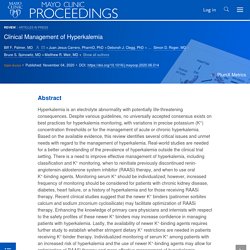
Tamargo J. Kjeldsen K.P. et al.Expert consensus document on the management of hyperkalaemia in patients with cardiovascular disease treated with renin angiotensin aldosterone system inhibitors: coordinated by the Working Group on Cardiovascular Pharmacotherapy of the European Society of Cardiology.Eur Heart J Cardiovasc Pharmacother. 2018; 4: 180-188Rafique Z.
Weir M.R. Onuigbo M. et al.Expert panel recommendations for the identification and management of hyperkalemia and role of patiromer in patients with chronic kidney disease and heart failure.J Manag Care Spec Pharm. 2017; 23: S10-S19Bandak G. Sang Y. Nutrition care for chronic kidney disease during pregnancy: an updated review. Nutrition therapy goals for pregnant women with CKD include to meet energy and nutrient needs for optimal fetal growth and development while promoting adequate metabolic control; to make individual recommendations for vitamin and mineral supplementation; and to promote a healthy lifestyle to improve maternal and fetal health.
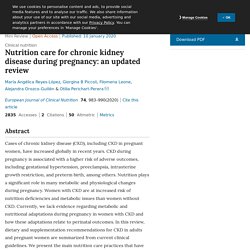
Energy and macronutrient recommendations in pregnant women with CKD Energy recommendations Resting energy expenditure (REE) appears to be higher in adults with CKD due to renal replacement therapy, poorly controlled diabetes mellitus (DM), severe hyperparathyroidism (HPT), and inflammation. In nondialyzed patients, REE tends to be equal or even lower than that of healthy individuals [10].
In stages 3–4 of CKD, the recommended energy intake is 96.2–146.4 kJ/kg/day (23–35 kcal/kg/day) using current weight [5]. Effects of omega-3 polyunsaturated fatty acid intake in patients with chronic kidney disease: Systematic review and meta-analysis of randomized controlled trials - Clinical Nutrition. High-protein diet is bad for kidney health: unleashing the taboo.
We use cookies to enhance your experience on our website.

By clicking 'continue' or by continuing to use our website, you are agreeing to our use of cookies. You can change your cookie settings at any time. We use cookies to enhance your experience on our website.By continuing to use our website, you are agreeing to our use of cookies. You can change your cookie settings at any time. <a href=" Find out more</a> Skip to Main Content.
Potassium homeostasis and management of dyskalemia in kidney diseases: conclusions from a Kidney Disease: Improving Global Outcomes (KDIGO) Controversies Conference - Kidney International. Diabetic kidney disease: New clinical and therapeutic issues. Joint position statement of the Italian Diabetes Society and the Italian Society of Nephrology on “The natural history of diabetic kidney disease and treatment of hyperglycemia in patients with.
Figure 1 Albuminuric and nonalbuminuric pathways of DKD progression.

DKD = diabetic kidney disease; GFR = glomerular filtration rate; ESKD = end-stage kidney disease. Despite the large body of evidence indicating the existence of different DKD phenotypes, it is still unclear whether the albuminuric and nonalbuminuric DKD models represent true distinct pathways underlying different pathogenic and pathophysiological mechanisms and what is the reason for the progressive switch from the classical albuminuric presentation to the new nonalbuminuric phenotypes, i.e., nonalbuminuric renal impairment and progressive renal decline. Box 1.1. Effects of Creatine Supplementation on Renal Function: A Systematic Review and Meta-Analysis - Journal of Renal Nutrition. Based on the above studies, we propose that creatine supplementation is safe, even for long periods of time.
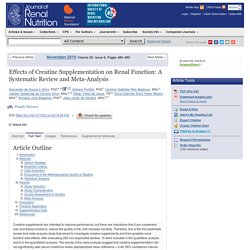
The present review (limited to full-text studies and reliable results) highlights the evaluation and inclusion of high quality studies. Limitations of the study include a lack of inclusion of additional variables related to renal damage for meta-analysis such as total protein, albumin, and globulin; however, the homogeneity of the data included could not be guaranteed. Therefore, we chose to include only variables with robust and reliable results.
Another limitation was the inclusion of studies only published in English and Portuguese; however, the studies were from the most reliable databases. A Global Approach to Increasing Physical Activity and Exercise in Kidney Care: The International Society of Renal Nutrition and Metabolism Global Renal Exercise Group - Journal of Renal Nutrition. Clinical practice guideline on pregnancy and renal disease. Structure of care Guideline 1.1 We recommend multidisciplinary teams (including a consultant obstetrician, consultant nephrologist/expert physician, and expert midwife or midwifery team) are established to offer advice and care for women with CKD who are pregnant or planning a pregnancy.
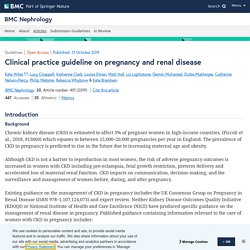
All healthcare professionals caring for women with CKD should be able to access this MDT (1D). Rationale Women with CKD have an increased risk of adverse pregnancy outcomes including pre-eclampsia, fetal growth restriction, preterm delivery and deterioration in maternal renal function. Clinical practice guideline on undernutrition in chronic kidney disease. 1.2.1 - We suggest that there should be a clear pathway for prompt referral to specialist renal dietitians when risk of undernutrition is identified.
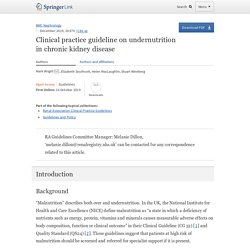
This pathway should include locally agreed timescales for formal assessment. (2D). 1.2.2 - We suggest that patients should be assessed by a specialist renal dietitian when they begin education about renal replacement treatment and within one month of starting dialysis or changing dialysis modality (2D). 1.2.3 - We suggest that formal nutritional assessments are carried out on those identified to be at risk by screening.
Potassium Additives and Bioavailability: Are We Missing Something in Hyperkalemia Management? - Journal of Renal Nutrition. Management of hyperkalemia in patients with kidney disease: a position paper endorsed by the Italian Society of Nephrology. Hyperkalemia in patients with diabetes In clinical practice, HK usually develops as an effect of combination of renal dysfunction and superimposed factors such as HF, high-potassium diet, use of medications inhibiting the RAAS and DM [6]. DM is indeed associated with increased risk of chronic HK, due to blunted insulinemic response to hyperglycemia with reduced K switch to intracellular fluid, plasma hyperosmolality, with enhanced K switch to extracellular fluid, and hyporeninemic hypoaldosteronism, with impairment in K tubular secretion, which plays a major role, especially in type 2 DM.
However, adaptation mechanisms may handle a K load and HK does not ensue in diabetic CKD (DKD) unless a reduction in renal function is present. Accordingly, chronic HK is highly prevalent in patients with DKD. Nutrition and Endocrine Disorders in Kidney Disease. Clinical practice guideline for renal hypouricemia (1st edition) Life with one kidney. Postnatal analysis In newborns with antenatal suspicion of CAKUT, postnatal analysis will minimally consist of an ultrasound, and renal scintigraphy may also be performed to confirm the absence of an ectopic functioning kidney. The debate on the need for a voiding cystourethrogram (VCUG) in all newborns with an SFK is similar to that regarding the indications after a urinary tract infection (UTI): the question remains of whether the detection of low-grade VUR adds value to the treatment of the patient [33]. The absence of significant pelvic dilatation is frequently used as a marker for the absence of high-grade VUR. Unfortunately, the predictive value of ultrasound findings for VUR is quite poor [34].
In individuals with SFK, the presence of VUR is associated with a higher risk of renal injury [8] and, therefore, the need to perform a VCUG may be higher than the need in the general population as it may assist in counseling of the family. Postnatal function Hyperfiltration injury Sports Diet. Clinical practice recommendations for native vitamin D therapy in children with chronic kidney disease Stages 2–5 and on dialysis. Skip to Main Content. Obesity Paradox in Advanced Kidney Disease: From Bedside to the Bench. Outline AbstractAbbreviations and acronymsKeywordsThe obesity paradoxMeasurements of body size and body compositionObesity and mortality in CKDObesity and mortality in ESRD treated with HDObesity and mortality in ESRD treated with PDObesity and mortality in ESRD treated with KTPotential mechanisms underlying the obesity paradoxCachexia and inefficient energy metabolismInflammationThe impact of fat distributionMore stable hemodynamicsEpidemiological limitations within the obesity paradoxConclusionStatement of conflict of interestAcknowledgementsFunding sourceReferences Tables (4) Table 1Table 2Table 3Table 4 JavaScript is disabled on your browser.
Please enable JavaScript to use all the features on this page. Abstract. Nutrients, Nutraceuticals, and Xenobiotics Affecting Renal Health. Green tea contains polyphenolic compounds (flavonoids) displaying antioxidant properties, known as catechins. These compounds have shown anti-oxidative, anti-inflammatory, and anti-carcinogenic activity [114,115,116]. There is evidence that increased antioxidant status lowers oxidative damage to DNA, thus enhancing protection against cancer [114,117]. In addition, epidemiological data have indicated a lower incidence of cancer in subjects with higher intake of green tea [118,119,120]. Prevention of acute kidney injury and protection of renal function in the intensive care unit: update 2017.
Rationale Relative and overt hypovolaemia are significant risk factors for development of AKI [15, 16, 17, 18]. Clinical Aspects of Natural and Added Phosphorus in Foods - Springer. CLINICAL PRACTICE GUIDELINES. Academy of Nutrition and Dietetics and National Kidney Foundation: Revised 2014 Standards of Practice and Standards of Professional Performance for Registered Dietitian Nutritionists (Competent, Proficient, and Expert) in Nephrology Nutrition. EVALUATION AND MANAGEMENT OF HYPERKALEMIA "MASTER CLASS" Dietary Phosphorus Intake and the Kidney. Long-Term Effects of High-Protein Diets on Renal Function. KDIGO 2017 Clinical Practice Guideline Update for the Diagnosis, Evaluation, Prevention, and Treatment of Chronic Kidney Disease–Mineral and Bone Disorder (CKD-MBD)